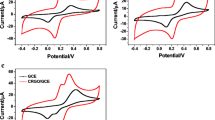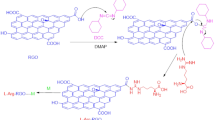Abstract
In this work, carboxyl-functionalized graphene (CFG) was immobilized on glassy carbon electrode (GCE) by self-assembled monolayers (SAMs) based on covalent interaction with ethylenediamine as an arm linker. The obtained (CFG-NHCH2CH2NH)/GCE can be used as rapid and sensitive electrochemical sensor for hydroxyl free radicals (•OH). In the process of determination, the concentration of •OH was acquired not directly but through the only captured product 3,4-dihydroxybenzoic acid (3,4-DHBA), which is adopting 4-hydroxybenzoic acid (4-HBA) as the •OH trap. The glassy carbon electrode modified with carboxyl-functionalized graphene exhibits well conductivity and electron transfer ability, and also displays good electrocatalytic activity towards the electrochemical redox of 3,4-DHBA. The proposed sensor displays a good linear range from 1.0 to 450.0 μM for 3,4-DHBA with a low detection limit of 0.17 μM (S/N = 3). More importantly, the sensing platform can be successfully applied for •OH detection with the 4-HBA as the •OH trap.








Similar content being viewed by others
References
Cuzzocrea S, Reiter RJ (2001) Pharmacological action of melatonin in shock, inflammation and ischemia/reperfusion injury. Eur J Pharmacol 426(1-2):1–10
Negishi H, Ikeda K, Nara Y, Yamori Y (2001) Increased hydroxyl radicals in the hippocampus of stroke-prone spontaneously hypertensive rats during transient ischemia and recirculation. Neurosci Lett 306(3):206–208
Yamamoto H, Watanabe T, Mizuno H, Endo K, Hosokawa T, Kazusaka A, Gooneratne R, Fujita S (2001) In vivo evidence for accelerated generation of hydroxyl radicals in liver of Long-Evans Cinnamon (LEC) rats with acute hepatitis. Free Radic Biol Med 30(5):547–554
Carrera V, Sabater E, Vilanova E, Sogorb MA (2007) A simple and rapid HPLC–MS method for the simultaneous determination of epinephrine, norepinephrine, dopamine and 5-hydroxytryptamine: application to the secretion of bovine chromaffin cell cultures. J Chromatogr B 847(2):88–94
Maezono T, Tokumura M, Sekine M, Kawase Y (2011) Hydroxyl radical concentration profile in photo-Fenton oxidation process: generation and consumption of hydroxyl radicals during the discoloration of azo-dye Orange II. Chemosphere 82(10):1422–1430
Gualandi I, Tonelli D (2013) A new electrochemical sensor for OH radicals detection. Talanta 115:779–786
Liang AH, Zhou SM, Jiang ZL (2006) A simple and sensitive resonance scattering spectral method for determination of hydroxyl radical in Fenton system using rhodamine S and its application to screening the antioxidant. Talanta 70(2):444–448
Gualandi I, Guadagnini L, Zappoli S, Tonelli D (2014) A polypyrrole based sensor for the electrochemical detection of OH radicals. Electroanalysis 26(7):1544–1550
Xiang Q, Yu J, Wong PK (2011) Quantitative characterization of hydroxyl radicals produced by various photocatalysts. J Colloid Interface Sci 357(1):163–167
Hu YL, Lu Y, Zhou GJ, Xia XH (2008) A simple electrochemical method for the determination of hydroxyl free radicals without separation process. Talanta 74(4):760–765
Ai S, Wang Q, Li H, Jin L (2005) Study on production of free hydroxyl radical and its reaction with salicylic acid at lead dioxide electrode. J Electroanal Chem 578(2):223–229
Pluangklang T, Wydallis JB, Cate DM, Nacapricha D, Henry CS (2014) A simple microfluidic electrochemical HPLC detector for quantifying Fenton reactivity from welding fumes. Anal Methods 6(20):8180–8186
Holmes CD, Jacob DJ, Yang X (2006) Global lifetime of elemental mercury against oxidation by atomic bromine in the free troposphere. Geophys Res Lett 33:20
Cao Y, Chu Q, Ye J (2003) Determination of hydroxyl radical by capillary electrophoresis and studies on hydroxyl radical scavenging activities of Chinese herbs. Anal Bioanal Chem 376(5):691–695
Lau C, Qin X, Liang J, Lu (2004) Determination of cysteine in a pharmaceutical formulation by flow injection analysis with a chemiluminescence detector. Anal Chim Acta 514(1):45–49
Ouyang J, Li ZQ, Zhang J, Wang C, Wang J, Xia XH, Zhou GJ (2014) A rapid and sensitive method for hydroxyl radical detection on a microfluidic chip using an N-doped porous carbon nanofiber modified pencil graphite electrode. Analyst 139(13):3416–3422
Schedin F, Geim AK, Morozov SV, Hill EW, Blake P, Katsnelson MI, Novoselov KS (2007) Detection of individual gas molecules adsorbed on graphene. Nat Mater 6(9):652–655
Tang L, Wang Y, Li Y, Feng H, Lu J, Li J (2009) Preparation, structure, and electrochemical properties of reduced graphene sheet films. Adv Fun Mater 19(17):2782–2789
Kafi AKM, Yusoff MM, Choucair M, Crossley MJ (2017) A conductive crosslinked graphene/cytochrome c networks for the electrochemical and biosensing study. J Solid State Electrochem 21(10):2761–2767
Niyogi S, Bekyarova E, Itkis ME, McWilliams JL, Hamon MA, Haddon RC (2006) Solution properties of graphite and graphene. J Am Chem Soc 128(24):7720–7721
Wang LT, Zhang Y, Du YL, Lu DB, Zhang YZ, Wang CM (2012) Simultaneous determination of catechol and hydroquinone based on poly (diallyldimethylammonium chloride) functionalized graphene-modified glassy carbon electrode. J Solid State Electrochem 16(4):1323–1331
Lee WH, Park J, Sim SH, Lim S, Kim KS, Hong BH, Cho K (2011) Surface-directed molecular assembly of pentacene on monolayer graphene for high-performance organic transistors. J Am Chem Soc 133(12):4447–4454
Mandler D, Kraus-Ophir S (2011) Self-assembled monolayers (SAMs) for electrochemical sensing. J Solid State Electrochem 15(7-8):1535–1558
Su L, Gao F, Mao LQ (2006) Electrochemical properties of carbon nanotube (CNT) film electrodes prepared by controllable adsorption of CNTs onto an Alkanethiol monolayer self-assembled on gold electrodes. Anal Chem 78(8):2651–2657
Li YC, Feng SQ, Zhong YM, Li YH, Li SX (2015) Simultaneous and highly sensitive determination of hydroquinone and catechol using carboxyl functionalized graphene self-assembled monolayers. Electroanalysis 27(9):2221–2229
Park JS, Cho SM, Kim W-J, Park J, Yoo PJ (2011) Fabrication of graphene thin films based on layer-by-layer self-assembly of functionalized graphene nanosheets. ACS Appl Mater Interfaces 3(2):360–368
Ste-Marie L, Boismenu D, Vachon L, Montgomery J (1996) Evaluation of sodium 4-hydroxybenzoate as an hydroxyl radical trap using gas chromatography–mass spectrometry and high-performance liquid chromatography with electrochemical detection. Anal Biochem 241(1):67–74
Miao L, Peterson LS, Minoru M, KeJian L (2002) On the application of 4-hydroxybenzoic acid as a trapping agent to study hydroxyl radical generation during cerebral ischemia and reperfusion. In: Vallyathan V, Shi X, Castranova V (eds) Oxygen/nitrogen radicals: cell injury and disease. Springer US, pp 379–385
DuVall SH, McCreery RL (1999) Control of catechol and hydroquinone electron-transfer kinetics on native and modified glassy carbon electrodes. Anal Chem 71(20):4594–4602
Wang W-S, Wang D-H, Qu W-G, Lu L-Q, Xu A-W (2012) Large ultrathin anatase TiO2 nanosheets with exposed {001} facets on graphene for enhanced visible light photocatalytic activity. J Phys Chem C 116(37):19893–19901
Wang J, Gao M, Ho GW (2014) Bidentate-complex-derived TiO2/carbon dot photocatalysts: in situ synthesis, versatile heterostructures, and enhanced H2 evolution. J Mater Chem A 2(16):5703–5709
Ren L, Qi X, Liu Y, Huang Z, Wei X, Li J, Yang LY, Zhong JX (2012) Upconversion-P25-graphene composite as an advanced sunlight driven photocatalytic hybrid material. J Mater Chem 22(23):11765–11771
Funding
This work was supported by the National Natural Science Foundation of China (No. 21175115); the Natural Science Foundation of Fujian province in China (2016J01067); and the Innovation Base Foundation for Graduate Students Education of Fujian Province.
Author information
Authors and Affiliations
Corresponding author
Rights and permissions
About this article
Cite this article
Li, Y., Li, Y., Zhang, Y. et al. A rapid and sensitive electrochemical sensor for hydroxyl free radicals based on self-assembled monolayers of carboxyl functionalized graphene. J Solid State Electrochem 23, 187–194 (2019). https://doi.org/10.1007/s10008-018-4118-5
Received:
Revised:
Accepted:
Published:
Issue Date:
DOI: https://doi.org/10.1007/s10008-018-4118-5




